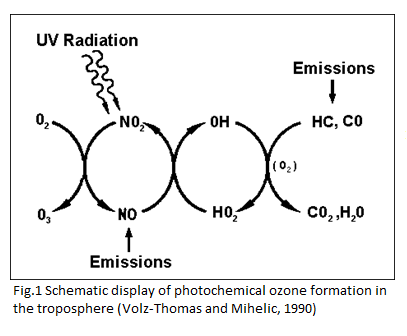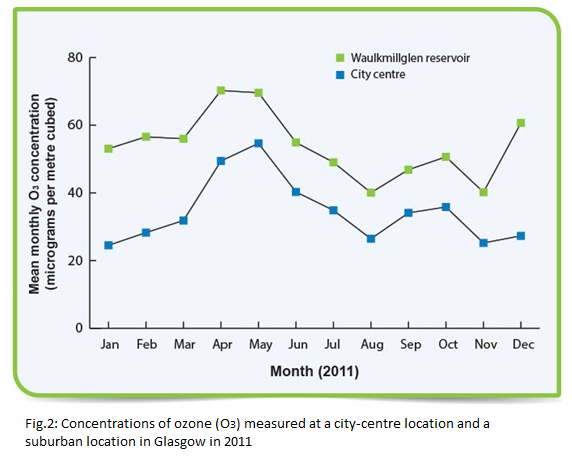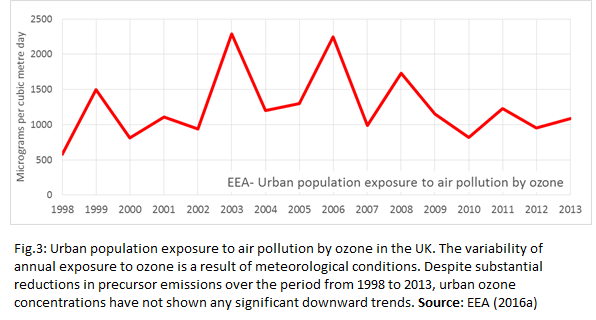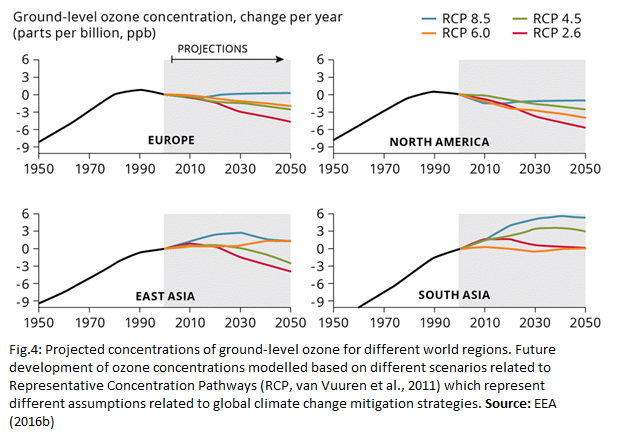Fifty years on from the introduction of the Clean Air Act, air pollution is still one of the biggest environmental threats we face. Over the last few months it seems like air quality has never been out of the news.
Scotland's environment web
February 09, 2016
There’s something in the air
It has been reported in the media that poor air quality in Scotland has been attributed to premature deaths and more recently emissions from vehicle exhausts have not achieved the level of improvement that we thought they would.
Our understanding of the sources and impacts of air pollution has improved over the years and we have been applying that knowledge to improve air quality in some areas. However, there are still areas in Scotland where poor air quality continues to affect human health and the environment.
Watch our short video on the state of Scotland's air quality or read the State of Scotland's environment air report.
https://www.youtube-nocookie.com/embed/wLAN9THZq6M
The quality of the air around us is affected by pollutants released into the atmosphere through human activities, such as transport and industry, as well as from natural sources. Our
air infographic explains more.
Air pollutants can have a serious impact on human health. Children and the elderly are especially vulnerable. Take a look at this infographic for more on health impacts.
Find out about the national approach Scotland is taking to tackle air pollution and achieve cleaner air for Scotland.
Want to know more about air quality data in your area? Have a look at the air quality maps on Scotland's environment website where you can query real time data about air and annual returns for atmospheric pollution. The data can be viewed at detail and includes further information about specific locations around Scotland, air classification reports and a link to more resources about pollutant types and how they can affect us.
Know & respond - Scotland is a free service to subscribers in Scotland that sends registered users an alert message if air pollution in their area is forecast to be moderate and above.
Business boost
Air pollution from your business can harm the environment by contributing to climate change and damaging land, water and wildlife.
Find out how to comply with air pollution legislation and the benefits of keeping air pollution to a minimum in the NetRegs online guide where some actions can actually save you money or have added benefits to greenhouse gas emissions.
Training your employees to be more fuel efficient could increase your drivers' MPG by up to 15%, helping your organisation save on fuel costs and reduce your carbon footprint. The FuelGood driver training from Energy Saving Trust.
Promoting active travel for employees will not only help you reduce your carbon footprint but can also dramatically reduce the number of sick days taken each year. Read about a Danish joint initiative between the European Commission and WHO Regional Office for Europe that reveals the health benefits of physical activity.
Working for the environment
For those working professionally with environmental matters, Scotland's environment web provides a wealth of data, tools and resources to assist you in your job.
On the subject of air quality we have the following suite of resources:
What's new on Scotland's environment website?
Scotland’s environment web map view gives users the option to query real time data about numerous topics and areas of interest. Select any postcode or area of interest around Scotland and view the data held by Scotland's environment web partners. Select multiple layers for a more complex view of the data. New this month:
Five things you didn't know about air pollution
- There are five main pollutants emitted into the air
- Monet's pictures of London were one of the first records of smog in the 1900's
- Lichens are natural indicators of air pollution, download an app to assess atmospheric nitrogen pollution using lichens, or take part in a lichen project to monitor air quality in your area
- Air pollution is estimated to reduce the average life expectancy of every person in the UK by six months, and costs the UK economy around £16 billion per year
- Across the whole world, livestock is the biggest source of methane
Serious science
This month’s serious science topic comes from Dr Stefan Reis (Centre for Ecology & Hydrology), where he provides us with a closer look at ground level ozone - a common air pollutant that can cause damage to the lungs and irritate the throat if inhaled, and is the main component of smog.
Urban Ozone
What is ground level ozone?
Ozone, often referred to as ground level ozone or tropospheric ozone, is formed in the lower atmosphere (the troposphere) by the action of sunlight on nitrogen dioxide (NO2). Nitrogen dioxide is naturally generated in the air by lightning or released from the burning of biomass and soil emissions. In developed regions the main source of man-made NO2 is from burning fossil fuels.
Ozone formation is accelerated by the presence of organic gases, so-called volatile organic compounds (VOCs), both naturally occurring and man-made (see Fig. 1). High concentrations of ozone at ground level are of particular interest, as they have adverse effects on human health, plant growth and production of agricultural crops. Ground level ozone is a short-term climate forcing pollutant so also contributes to climate change.
Ozone is toxic to plants, animals and humans; toxic concentrations are found in polluted air, downwind of NO2 sources and especially in strong sunlight. Ozone is removed from the atmosphere by deposition to plants, and also by reaction with nitric oxide (NO) in the air to form NO2. Both NO2 and NO are typically summarised as nitrogen oxides (NOx). A comprehensive analysis of our current understanding of ozone formation and trends has recently been compiled by Monks et al. (2015).
Ozone trends
Before industrialisation, ground level ozone concentrations were approximately 10 ppb (parts per billion, approximately 20 μg m-3) globally. Man-made emissions of the precursor gases have increased this background concentration to 20-30 ppb. However, elevated concentrations of ozone can be much larger than the ‘background’ because of the accumulation of local or regional variations in precursor emissions. These elevated concentrations can vary by factors of 10 to 100 over a typical city and its suburban to rural surroundings.
Future challenges
Traditionally, high levels of ground level ozone were most often observed downwind of cities in rural environments, as pollution masses dispersed out from the cities and the mix between NO2 and NO accumulated in favour of O3 formation. This generated a difference in ground level ozone between the more polluted city centre and the suburban and rural areas, resulting in lower background concentration in city centres.
More recent effects of policy measures aimed at reducing the emissions of ozone precursor pollutants has resulted in changes in atmospheric composition across cities that favour ozone formation. This presents challenges for air pollution control policies, as significant further reductions of NOx will be required to substantially reduce urban ozone concentrations, and as a result, population exposure. In addition, any measures implemented to reduce emissions of air pollutants and greenhouse gases need to be assessed with regard to their effect on ozone concentrations, to avoid unintended consequences.
In Europe and the UK, maximum ozone concentrations have been seen to slowly decline over the past decade, while mean concentrations have been level or shown a slight increase due to global background ozone concentrations continuing to rise. While the mechanisms underlying these trends are not yet completely understood, emissions of ozone precursors in the growing economies in East and South Asia and hemispheric transport of these precursors may be a main contributor.
References
- European Environment Agency (2016a) ec.europa.eu/eurostat/web/products-datasets/-/tsdph380 (Fig.3)
- European Environment Agency (2016b) eea.europa.eu/data-and-maps/figures/ds_resolveuid/SN5BJGYVE7 (Fig.4)
- Monks, P. S., Archibald, A. T., Colette, A., Cooper, O., Coyle, M., Derwent, R., Fowler, D., Granier, C., Law, K. S., Mills, G. E., Stevenson, D. S., Tarasova, O., Thouret, V., von Schneidemesser, E., Sommariva, R., Wild, O., and Williams, M. L.: Tropospheric ozone and its precursors from the urban to the global scale from air quality to short-lived climate forcer, Atmos. Chem. Phys., 15, 8889-8973, doi:10.5194/acp-15-8889-2015, 2015. atmos-chem-phys.net/15/8889/2015
- Salvo A and Geiger F M 2014 Reduction in local ozone levels in urban Sao Paulo due to a shift from ethanol to gasoline use Nature Geoscience 7 450-8. nature.com/ngeo/journal/v7/n6/abs/ngeo2144.html
- Scotland's environment website environment.scotland.gov.uk/get-informed/air (Fig.2)
- Van Vuuren et al (2011) The Representative Concentration Pathways: An Overview. Climatic Change, 109 (1-2), 5-31.
- Volz-Thomas, A., Mihelic, D. (1990) Ozonproduktion in Reinluftgebieten. Einfluß von Schadstoff-Konzentrationen, Gesellschaft Österreichischer Chemiker (Hrsg.), Tagungsband zum Symposium "Bodennahes Ozon" in Salzburg, Bd. 11 der Schriftenreihe "Umweltschutz". (Fig.1)
If you only did one thing...
To contribute to better air quality engage leg power: leave the car behind for all those short trips and walk instead. You cut down on CO2 emissions and help create a cleaner, less congested Scotland. You'll feel great too – walking helps us cope with stress, burns calories and feels good.
Greener Scotland has some great advice, tips and suggestions for active travel and reducing emissions.
Everyday’s a school day
Looking for resources to help discuss air quality in the classroom? You'll find lots of Curriculum for Excellence aligned resources on get learning and the learning about air quality teaching package.
Read how these young learners changed attitudes that will lead to better air quality at their school.
Challenge your learners to become air pollution detectives with this fun online game.
Still time to enter but be quick. Closing date for Our Environment Competition extended to 22 April. Look at previous winning schools including an entry on air quality from Panmure St Ann's secondary school.
Video of the month
By prioritising a number of policy objectives including climate change, health and greenspace, we can work together to achieve benefits that go beyond improving air quality. Watch SEPA's Making the Case for the Environment: Air quality video to find out more.
https://www.youtube-nocookie.com/embed/Fo0leoCg1EA
And finally...
Still want to know more about air quality? Here's a great round-up of data, tools, maps and links about air quality on Scotland's environment web.
Adobe Acrobat Reader is the free, trusted leader for reliably viewing, annotating and signing PDFs.
Download Adobe Acrobat Reader




